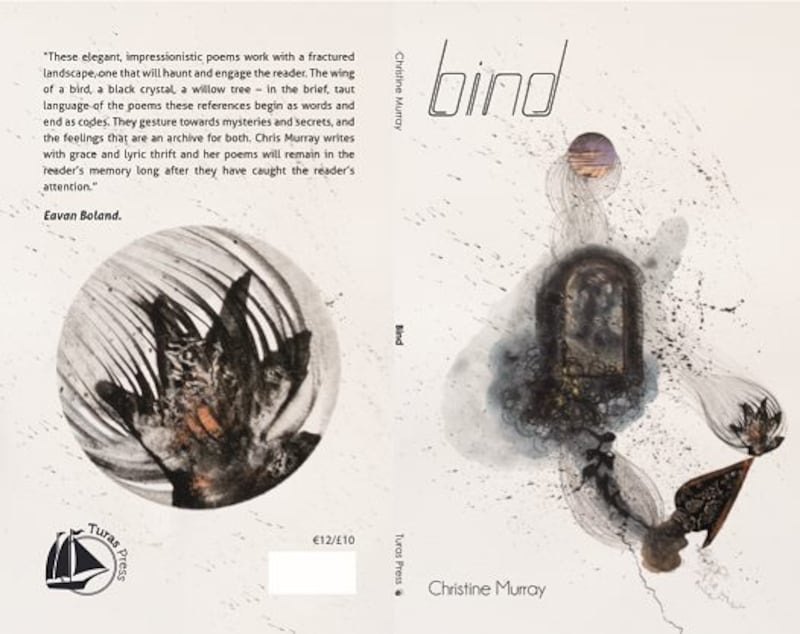I am a poet without a landscape, a woman poet without a narrative heritage. I began tracing the huge startling landscape of US and European women's poetry while in college. I could not find its equivalent here in Ireland. bind reflects the facts of absence and fragmentation in my poetry landscape, and the absence of women poets in our cultural narrative. bind is a book-length poem loosely divided into chapters. These chapters act as boundaries within the action of the poem and provide gateways to differing aspects of the processes inherent in bind. The title of the book takes its name from the triple hyphenation that occurs irregularly within the first chapter. bind explores movement, objects and colours that occur in a no-place or a stasis, the fragmented landscape,
bind
if there are birds here,
they are of stone.
draughts of birds.
the flesh-bone-wing
of 'bird'
(from bind – Chapter One)
There are things that intrigue and preoccupy me as a poet. These are, conveying movement on a static page, describing processes that are both imaginative and organic, and trying very hard to ensure that my private symbol-use means something to my reader.

The attempt to convey movement within a poem sets up a tension between the moving object and the static page. Tabernacle, recently published in an anthology of English and Farsi poetry, Persian Sugar In Indian Tea (edited and translated by Soodabeh Saeidnia) demonstrates this tension.
Tabernacle
gold-bodied a beetle dives
into muck and dirt, a silica
of glitter on his porch,
his wing.
there is no evidence of his home now
it is vanished,
small soil tabernacle
he carried in the sun.
bind did not emerge easily. It began its life as a work of collaboration (Compose Journal). The process of rescuing my part in the text was very arduous and intricate. There were times when I wanted to throw the notebooks against the wall, or preferably burn them, but it wouldn't let me go. Some time last summer, two almost-chapters emerged and I began to write down the images that I found, threading them into the narrative of what was finally to become the book.
Describing imaginative and organic processes is a bugbear. You have to let the process, whatever it is, take you through it. The process can be a grief which presents us with a new geography, an unfamiliar landscape. The idea of bind is in abandonment to a process from which there is no guarantee that we will emerge intact.
My interest in process comes from my job as a stonecutter. Here, I would wait for huge, unhewn rocks to arrive and somehow visualise them as part of a building, a corbel, a balcony, a mullion or something that felt vast but hidden in the language of the stone that would be piled up in my workshop. The process in bind is both similar and different – not an unearthing, but a shaping. Things appear in bind that have no relation to reality. They come in through the eye and they bring with them a story.
One of my goals in writing bind was to make my private universe of symbols accessible to the reader, while retaining the integrity of the work. I am absurdly grateful to Salma Caller, an artist whose work has intrigued and moved me, since she appeared on my social media accounts. Salma created a cover for my chapbook A Hierarchy of Halls (Smithereens Press, 2018) so I sent her bind in a rough form. She sent back the cover-image for the book. Salma's art was my first indication that the book created response in the reader.
I am grateful to Eavan Boland who read the text and produced a paragraph endorsing it. I know a close reader when I see one. Eavan's response was beautiful and it means a lot to me as a poet. Liz McSkeane of Turas Press accepted bind for publication. I have three collections and three chapbooks, but this is my first time working on a full-length book with an Irish publisher and it means the world to me to be accepted and published in my native city. Thank you, Liz. I hope you get many poets who should know that the life of poetry subsists in the small press where we are free to experiment. I asked Peter O'Neill to launch the book, as he has written about the small universe of recurrent symbols that sometimes make themselves known in my other books and he understands the mechanism of relatedness that can occur across books, often in unforeseen ways and quite often they occur unexpectedly after years of absence.
This book bind rejects transcendence, although it yearns deeply for it. The presence in bind is subject to organic laws of growth and decay. Thematically, bind is about necessity and the process of recovery even when it is unwelcome to us. (If you are a devotee of the transhumanist or post-humanist movement look away now!) The book is a song of devotion to nature in its microscopic form and it becomes an elegy in the first instance.
Dear reader, I hope you like bind. Creating it has been quite the journey of false starts, frustrations, taking apart and putting back together objects and things which eventually found their space in a book. In many ways, the process was very difficult for me, yet I do not regret a minute of it. I am free now to begin again.
Bind launched in the Irish Writers Centre on October 8th. I read in Barcelona on October 18th at a Fired! event coinciding with the Biblioteca Nacional de España's third annual celebration of Women Writers' Day. (This year's theme: Rebels and Transgressors) and will read in Belfast on November 6th for Fired! A Shadow Hid Me to mark one year of Fired! Irish Women Poets and the Canon.









